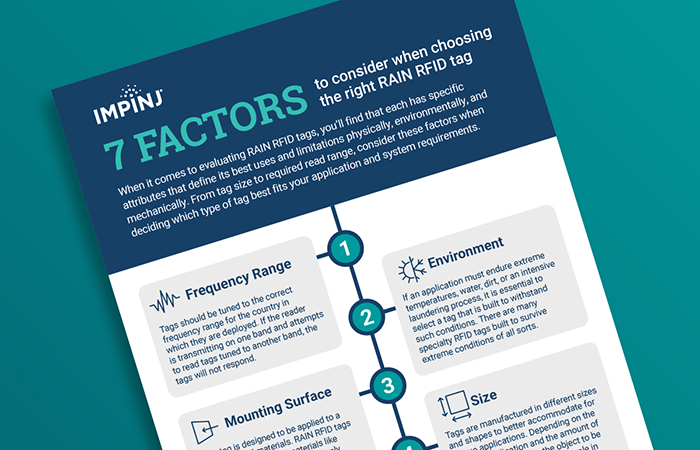7 Factors to Consider When Choosing a RAIN RFID Tag
Deciding which RAIN RFID tags to use for your application is not as easy as you may think. Here's everything you need to know.
RAIN RFID tags, also known as UHF RFID tags, come in a variety of sizes and shapes to meet the needs of all kinds of applications. With so many uses for RAIN RFID throughout various industries and markets, there are thousands of different tags for you to choose from. As you begin to review their specific attributes and best use cases, you may find yourself looking for more direction on how to select the right RAIN RFID tags for your deployment.
If you’re here, you likely understand the difference between passive RFID and active RFID. That is a great place to start. UHF or “RAIN” RFID is a passive, battery-free, wireless IoT technology that connects billions of everyday items to the internet. It can identify up to 1,000 items per second from a distance of up to 10 meters — all without direct line of sight.

Because of these capabilities, RAIN RFID tags in general are cheaper, smaller, and easier to manufacture than active, battery-powered RFID tags. Learn more about the differences and why Impinj RAIN RFID is a fantastic solution for just about any application.
We've crafted this resource — along with additional materials linked below — to help you decide which type of RAIN RFID tag (or tags) best suit your application and system requirements. We at Impinj are happy to help you discover the best solution for your application; feel free to contact us or reach out to your Impinj representative.
- Download infographic: What You Need to Know When Choosing a RAIN RFID Tag
- Watch webinar: “Choosing the Best RFID Tag for Your Application” with Impinj partner AtlasRFID
How do I choose the right RAIN RFID tag?
When it's time to choose RAIN RFID tags, consider:
1. Your region and frequency range
RAIN RFID tags are suitable for all kinds of applications and operate within a variety of frequencies around the world — all of them in what’s known as the ultra-high frequency (UHF) radio band. Every country has its own regulations for radio frequency use, and RFID deployments must comply with local rules. Even if you’re considering a RAIN RFID tag or reader advertised for “universal” use, it’s important to choose hardware that will operate correctly in your country or region.
2. The environment of your deployment
If your RAIN RFID tag is attached to an item that will be outdoors or in an environment where it will encounter extreme temperatures, you will want a durable tag that can withstand such conditions. Pay close attention to your tag’s ingress protection (IP) rating. IP ratings denote a device’s resistance to dust, dirt, and moisture like steam and water. There are RAIN RFID tags optimized for just about everything from high-temperature environments to rainy climates, ensuring the tags remain resilient over time.
3. Where to mount your tags
Tags are designed to attach to a variety of different surfaces. They can be mounted directly to a surface, applied as a label, connected as a hangtag, or sewn into fabric. Embedded RFID tags are broadly recommended for nonmetal surfaces like plastic, cardboard, and wood, while other types of tags may be more suitable for materials that can interfere with radio signals, such as metal, glass, or containers with liquid. Also, avoid attaching tags in a way that might obscure important product information like ingredients, instructions, or legal disclaimers.
4. How to attach your tags
Tags can’t be affixed to items without some sort of attachment method, and a single method may not work for everything you want to tag. Attaching a tag to porous material like wood may require a screw, while metal requires an epoxy or heavy-duty adhesive, especially if the tag experiences hard impacts or is exposed to harsh weather. However, if you’re tagging clothing or other soft items, a hang tag or sewn-in tag may be more appropriate.
5. The best size of RFID tag
There are many factors that contribute to the selection of your RAIN RFID tag’s size. The material or surface, the required frequency strength, the size of the tag chip, and the goals of the deployment will all help determine the right size tag for your application. Smaller surfaces may require smaller tags, but smaller tags may mean diminished performance. Larger tags may also obscure important information on a package. Next-generation Impinj RAIN RFID tag chips are small in size and high in performance, bringing greater capability to smaller tags.
6. The distance your tags will communicate
No two jobs are the same when it comes to performance and read range requirements. Some RAIN RFID deployments — such as those in warehouses, manufacturing facilities, and other large spaces — may require a tag with a long read range, while systems in smaller spaces like retail stores and offices may require a shorter read distance. Knowing your read-range requirements will help you determine what type of tag is best for your job.
7. How much data you need to store
Considering your application’s memory requirement is crucial to selecting the right RAIN RFID tag. The more data you need to encode on the tag chip, the more memory your tag should feature. Most data associated with a tagged item lives in a database or in the cloud, but some deployments may require storing additional information — such as batch or lot numbers, net weight, or use-by dates — directly on the tag chip. Impinj offers RAIN RFID tag chips with extended memory for such deployments.
Knowing these factors can make all the difference when it’s time to choose which RAIN RFID tags will help you execute the most successful deployment. Be sure to download our infographic on choosing the right tag, and check out our webinar with AtlasRFID on the same subject. To learn more about the benefits of RAIN RFID, you can also subscribe to the Impinj blog.
- Article tagged as:
Monday, April 22, 2024
ABOUT THE AUTHOR

Martha Mallon
Senior Director, Global Partner Marketing
Martha Mallon works with Impinj resellers and OEM partners to develop and deliver integrated joint marketing programs for partners’ products and solutions.
Sign Up for the latest news
